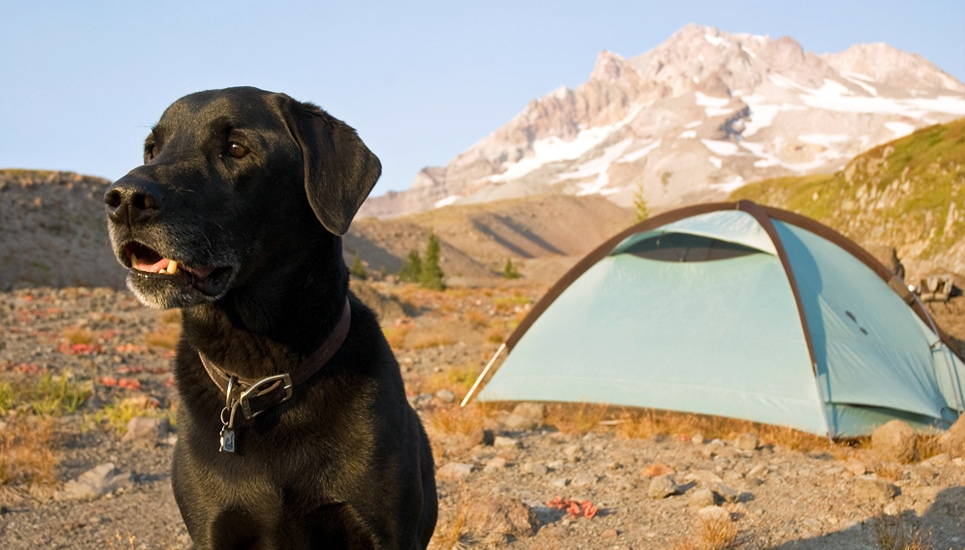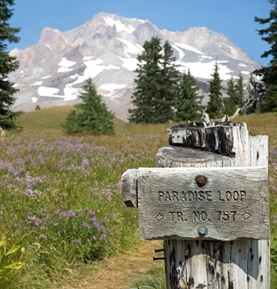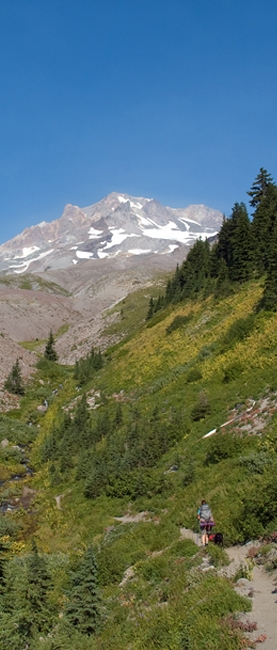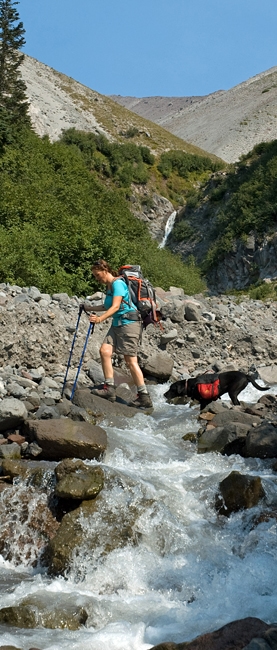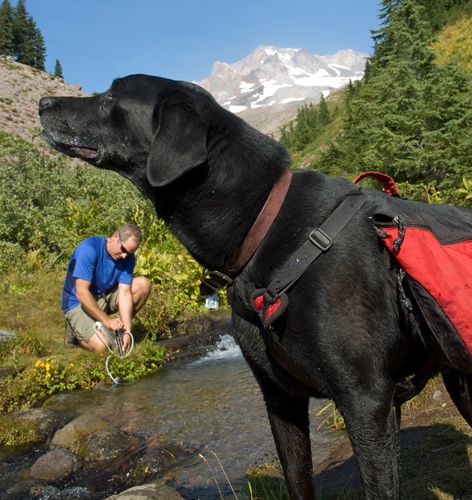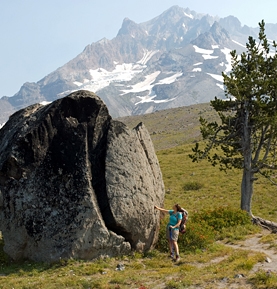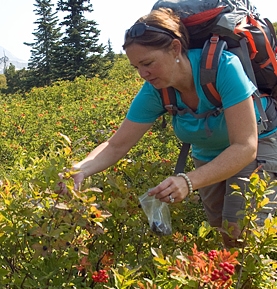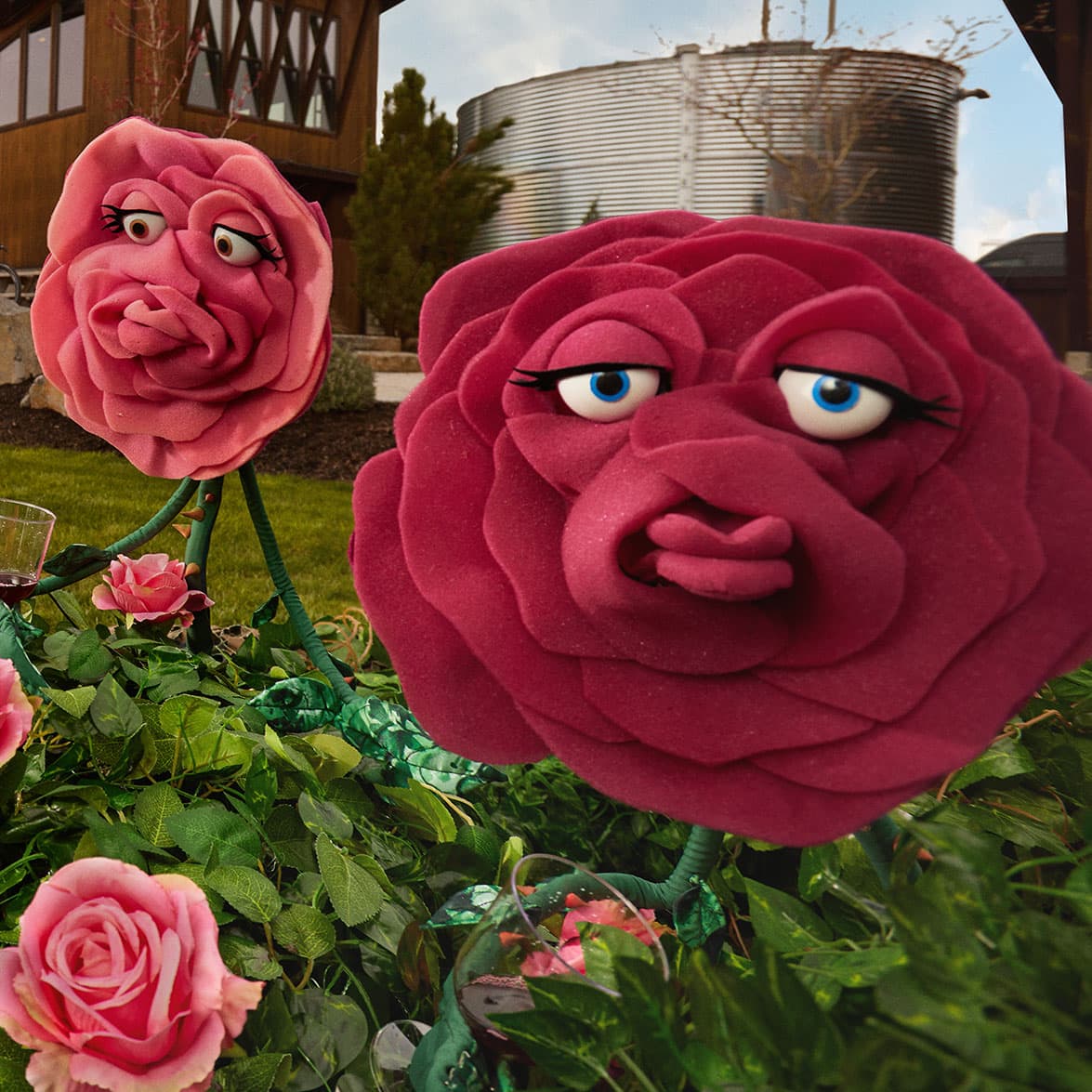I know this mountain . . . right?
I mean, I’m no native Oregonian, but I’ve lived here for a respectable 18 years. In that time, I’ve traipsed all over Mt. Hood — past Burnt Lake and up to Zigzag Mountain, over to McNeil Point, nearly to the top of Barrett Spur, out to Owl Point (a place not known to many of even the most seasoned Hood fans), through Elk Meadows and up Gnarl Ridge. I’ve been to the summit four times, circled around the entire beauty twice on the 41-mile Timberline Trail, snowshoed to Cloud Cap, skied White River and paddled around Lost Lake.
And yet, in all that wandering, I’ve never spent the night here, never pitched the tent among the wildflowers, burbling streams and wide-open views of this absolute Mt. Hood favorite — Paradise Park.
A patchwork of high alpine meadows, streams and scree fields at about 6,000 feet on Hood’s southwestern shoulder, the Paradise Park trail is one of the mountain’s classic hikes. It’s a 12-mile loop that gains 2,300 feet between Timberline Lodge and Paradise Park; it’s best in summer through very early fall. A park in name only, Paradise is a primitive, peaceful place in the federally protected Mt. Hood Wilderness. You need a self-issued wilderness permit for the hike, some experience, physical conditioning and a sense of adventure.
It’s all backpacking in Paradise: no bathrooms, no reservations — nothing but one of the best alpine wilderness experiences the mountain has to offer.
Inspired by a hike earlier in the summer to tiny Dollar Lake — a hidden gem in the mountain’s north shadow — my wife, Amy, and I ditch the kids and set out exploring in early fall. I’d plowed through Paradise once before trying to catch up with some friends who’d gotten a head start, but on that hike, my eyes barely left the main trail, and my feet surely hadn’t.
The day Amy and I set out is immaculate on the mountain. When we arrive at Timberline Lodge, not a cloud smudges the blue sky. It had been hot down in the valley, but halfway up the mountain, at 5,000 feet, we’re at a breezy 75 degrees. Even Oliver, our 10-year-old black Lab, has a spring in his step.
With our hefty packs on (Oliver carries his own share), we three look a tad over-prepared for the first mile or so of the trail to Paradise. The path starts just up the hill from Timberline, so it’s a popular way for visitors to get a little taste of the mountain. More than a few folks cast curious glances at our packs; even more smile at Oliver’s.
It’s a gentle descent along the Timberline Trail — which, here, doubles as a stretch of the Pacific Crest Trail — over to the edge of the ski area, past a gaping view of Zigzag Canyon and the sheer Mississippi Head, down through the trees to the Zigzag River. At this spot, if not before the giant drop down to the river, a majority of day hikers turn back for the lodge. You can’t blame them when you see the topography on the other side of the river. If you look high enough, you can almost see where you’re heading if Paradise Park is your destination. It is at least 1,000 feet up from the river, though it appears even higher. It does not look fun.
It turns out, though, that it’s not all that bad. Maybe it’s the occasional view of the summit — the kind that makes you stop on the trail and just gaze — or the cool breeze or the sensation of heading somewhere totally new. Amy and I started backpacking together in the Desolation Wilderness outside of Lake Tahoe in 1997. Back then every hike and campout had an excitement of discovery about it. There’s some of that feeling on this trip, for sure.
We fill our hydration packs from a crystalline stream and stroll into Paradise Park proper with high hopes of having the pick of campsites. A U.S. Forest Service volunteer we’d talked to on the trail had said one of the absolute money spots, Split Rock, was wide open just before we’d crossed paths. By the time we get there, though, it’s booked. However, the site we end up with isn’t much to moan about: a sweeping mountain view to the east, an endless vista to the west that somehow includes the Columbia River, a stream down below and the giant moon just short of full. We explore a bit, but the 6-mile hike and the quiet — save for one camper nearby chastising another for starting a small campfire in a restricted area — leave us with the desire to simply relax, inhale and take in this new side of the mountain. (Campfires are allowed in some areas in the Mt. Hood Wilderness when fire levels are low enough. Campers should check with the Zigzag Ranger District about specific regulations for different camping sites in Paradise Park.)
There’s more of that newness the next morning after breakfast and packing up. We check out the Split Rock site, which is indeed a prime campsite, what with its massive namesake formation, idyllic shade tree and grandiose alpine backdrop. We pick fat huckleberries to take back to the kids, and in trying to lead Amy to a grand viewpoint I know of, I stumble on another new glimpse of the mountain I’ve never seen before. It’s a jaw-dropping look up the expansive Paradise Branch canyon, a massive gash cut by a small stream that starts high up on Mt. Hood and ultimately tumbles its way down to the Sandy River. Then we loop back on an unfamiliar section of the Timberline Trail, passing pretty 20- to 30-foot falls at Lost Creek and Rushing Water Creek — falls we’ve never seen.
It’s only once we’re working our way back across the Zigzag River and slogging and sweating our way back toward Timberline Lodge that it all starts to look familiar again. Yes, there’s the canyon overlook and Mississippi Head, the wilderness boundary sign, the day hikers and, finally, the first of the ski lifts. It’s a relief to shed the packs and the boots in this parking lot we know so well.
Having finally spent a night in the storied Paradise Park, though, I’m left wondering where else I haven’t been on this mountain, what else I may not know. Something tells me I’ve got a ways to go.
